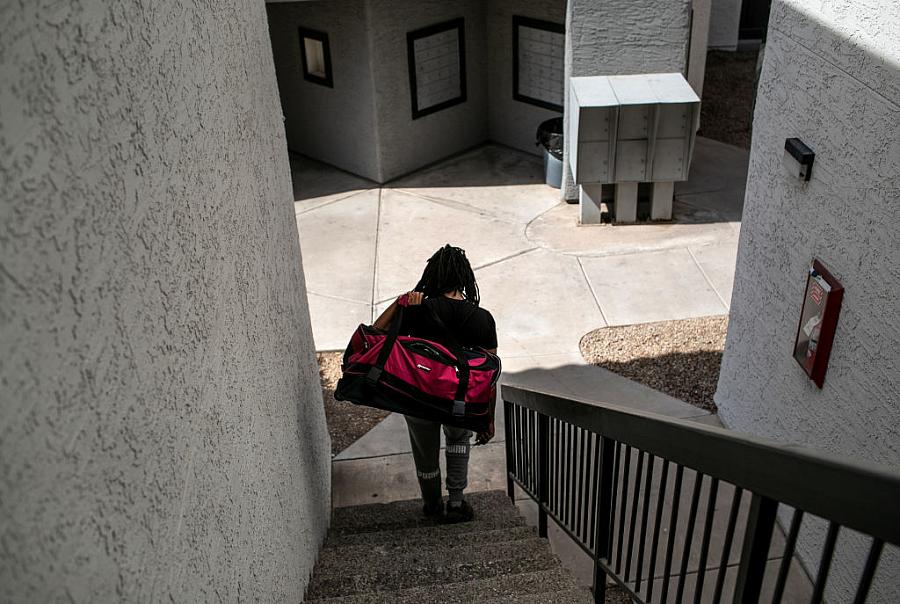County eviction data said nothing about race. Here’s how I showed who’s hardest hit.

(Photo by John Moore/Getty Images)
Gabriel Guzman, a father of three and former Marine, knew how property management in San Diego County worked. He had owned a home and managed apartments. He knew how landlords could — and should — treat tenants.
Yet as the COVID-19 pandemic unfolded, Guzman and his family, like many families of color across the country, faced repeated threats of evictions. Around them in San Diego County, families in majority-Latino neighborhoods like theirs experienced lockouts at a rate 17.7 percent higher than residents of majority-white neighborhoods. A growing body of research shows that such instability has short- and long-term health consequences not just for parents who must navigate housing challenges, but also for their children.
When I decided to examine and quantify how evictions upended families across the country, I immediately thought of people who looked like me. I had been writing about race and inequity for years at Mother Jones. I knew that no matter the crisis — whether it was who contracted or died of COVID, who suffered in childbirth, or whose children were stuck in under-resourced schools — Black and Latino people felt the impact disproportionately.
I empathized with Guzman more than he may have realized. At the time of the reporting, my family had been displaced from our apartment for months.
But I also knew that race and other demographic details were not readily available in eviction data. When I requested data from counties across California, I received names, addresses, and dates and times of executed evictions but no race or gender indicators.
Other researchers, such as UC Berkeley’s Tim Thomas and The Eviction Lab, used last names and other information as proxies to determine the race and gender of evicted tenants. That approach had flaws — what about a name like Johnson?
So I decided to take a different approach. What if we mapped out where evictions took place and determined how many occurred in predominantly Black and Latino census tracts?
California, one of the most diverse states in America, offered a fascinating window into the unequal geography of evictions. Eviction records are hard to come by, but sheriff’s departments, through public records requests, gave information on “lockout notices”— the last leg of the eviction process. Those notices accounted for a fraction of evictions but gave a picture of how and where evictions were concentrated over time.
By geocoding addresses and pairing lockout data with census data, we could figure out which communities faced the highest concentration of evictions. We calculated each census tract’s racial makeup to determine whether evictions took place in majority-white or majority-minority neighborhoods.
Decades of academic research backed our findings. Analysis of five California counties from March 13, 2020 to October 2021 found that even as evictions proceeded at lower rates during the pandemic, they continued to disproportionately affect residents of majority-Latino and majority-minority neighborhoods. In other words, one’s zip code could shape one’s risk of housing instability. The community’s racial makeup factored into the risk.
Our analysis required creative thinking. But to reveal a societal truth requires thinking differently. I left Mother Jones toward the end of publication to work as a senior reporter for The Guardian covering racial inequity, with an eye toward housing and education. I’ve since requested data from every county in California, and I want expand this type of analysis to other cities and states.
Ultimately, our findings added to growing body of research and reporting on the inequitable toll of evictions. The Pulitzer Prize-winning book "Evicted," by Matthew Desmond, a professor of sociology at Princeton, pushed that conversation to the national forefront. I also hope it reframed the way people look at the impact of evictions on communities and pushed that conversation beyond class. Inequities by race and class may be intertwined, but race has shaped public policy in America since its founding. It not only dictates what neighborhoods people have access to, but also where they face a heightened threat of housing instability.
The Data Fellowship experience opened the door toward a deeper understanding of how to marry reporting and storytelling driven by empathy while examining the racial disparities underpinning different avenues in American life. Data amplifies the stories we tell. It magnifies the anecdotes we hear and what we see in the world. But as I read hundreds of documents, I reminded myself that each name on spreadsheet after spreadsheet had a story. The policy choices that we simply accept determined people’s livelihoods during a pandemic and shape their lives far longer than we know.
**

